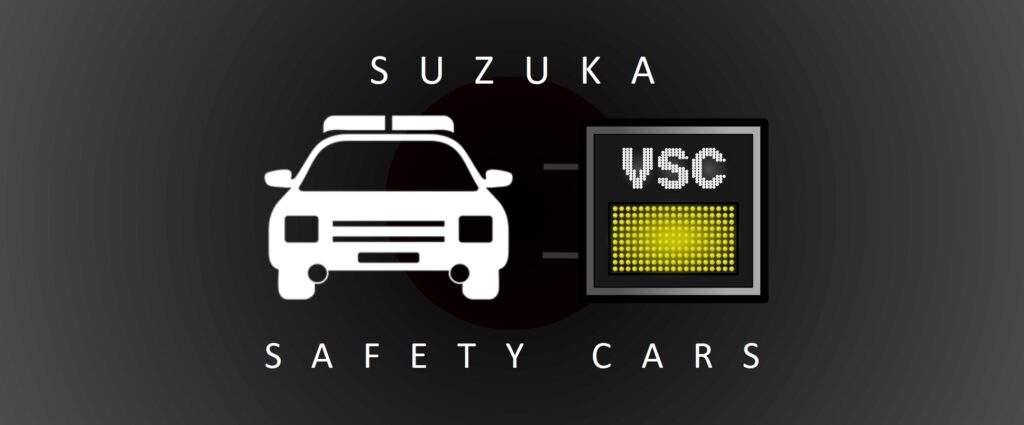
From crashes on the starting grid to torrential weather conditions, here’s a list of every time that the Safety Car has been deployed during the Japanese Grand Prix at Suzuka.
1994 Japanese Grand Prix, Lap 4
Heavy rain caused aquaplaning in the early stages of the 1994 Japanese Grand Prix. Johnny Herbert’s spin off track brought out the Safety Car, but Ukyo Katayama and Taki Inoue also spun out in the following moments.
1994 Japanese Grand Prix, Lap 14
Following a red flag period due to the weather conditions, the race restarted behind the Safety Car. It was the first time this occurred in Formula 1. The 1994 Japanese Grand Prix was also the first F1 race to feature two Safety Car periods.
2005 Japanese Grand Prix, Lap 2
The Safety Car did not make another appearance at Suzuka for 11 years. Juan Pablo Montoya destroyed the left hand side of his McLaren at the final corner, crashing out on the second lap of the 2005 Japanese Grand Prix and necessitating a Safety Car period.
2009 Japanese Grand Prix, Lap 45
Jaime Alguersuari crashed at 130R towards the end of the 2009 Japanese Grand Prix.
2010 Japanese Grand Prix, Lap 1
Vitaly Petrov did not make it past the starting lights at the 2010 Japanese Grand Prix, crashing on the starting grid with Nico Hulkenberg. Felipe Massa and Vitantonio Liuzzi were also out in the opening turns after colliding.
2011 Japanese Grand Prix, Lap 24
The Safety Car was brought out on Lap 24 of the 2011 Japanese Grand Prix, due to debris on track at Turn 7 and the final chicane.
2012 Japanese Grand Prix, Lap 1
Fernando Alonso crashed out after getting a wheel on the grass following contact with Kimi Raikkonen in the opening turns of the 2012 Japanese Grand Prix, while Nico Rosberg was eliminated in a collision which also involved Mark Webber and Romain Grosjean.
2014 Japanese Grand Prix, Lap 1
The 2014 Japanese Grand Prix began behind the Safety Car in heavy rain. The weather conditions saw the red flag shown at the end of Lap 2.
2014 Japanese Grand Prix, Lap 3
The 2014 Japanese Grand Prix resumed under Safety Car conditions, which lasted for seven laps before the track was deemed dry enough to race.
2014 Japanese Grand Prix, Lap 44
In deteriorating weather conditions, the Safety Car was deployed for only a handful of laps before the race was stopped once more and would not resume. Adrian Sutil had crashed out in the slippery conditions. Jules Bianchi then crashed at the same corner, colliding with a recovery vehicle. The race result was declared after 44 laps – though 46 were completed in total.
2017 Japanese Grand Prix, Lap 2
On the second lap of the 2017 Japanese Grand Prix, Carlos Sainz crashed out. This was the Spaniard’s final appearance with Toro Rosso before moving to Renault for the next race.
2017 Japanese Grand Prix, Lap 9
The VSC – which was introduced as a result of Jules Bianchi’s crash in the 2014 Japanese Grand Prix – made its first appearance at Suzuka in the 2017 race. Marcus Ericsson crashed out on Lap 9, with a VSC period required to remove the car from the gravel trap. The VSC period lasted just under three minutes.
2017 Japanese Grand Prix, Lap 48
Lance Stroll stopped in the opening sector after sliding through the gravel trap in the opening esses with a puncture. The VSC was out for four and a half minutes while his Williams car was cleared from the track.
2018 Japanese Grand Prix, Lap 4
Debris from Kevin Magnussen’s wheel and further debris at the pit exit on the main straight following a collision between the Haas driver and Charles Leclerc saw the Safety Car deployed in the early stages of the 2018 Japanese Grand Prix.
2018 Japanese Grand Prix, Lap 41
Charles Leclerc pulled up with a broken car after running off track through the Degner corners. The VSC was deployed for little over a minute while the Sauber was removed from the track.
2022 Japanese Grand Prix, Lap 2
Carlos Sainz and Alex Albon both crashed out in wet weather conditions on the opening lap of the 2022 Japanese Grand Prix. After a brief Safety Car period, the weather conditions saw the race red flagged after only three laps.
2022 Japanese Grand Prix, Lap 4
The Safety Car led the drivers around for a rolling restart at the 2022 Japanese Grand Prix.
2023 Japanese Grand Prix, Lap 1
Following contact between a number of midfield drivers on the run to Turn 1 on the opening lap, the Safety Car was called out towards the end of Lap 1. No drivers retired in the incident but debris was left strewn across the track. The Safety Car stayed out until the end of Lap 4.
2023 Japanese Grand Prix, Lap 14
There was a brief Virtual Safety Car on Lap 14 following contact between Sergio Perez and Kevin Magnussen at the hairpin, which left the Haas driver pointing in the wrong direction.
2024 Japanese Grand Prix, Lap 2
When Daniel Ricciardo and Alex Albon collided on Lap 1 of the 2024 Japanese Grand Prix, there was an immediate red flag instead of any Safety Car call outs. After the red flag period, the formation lap back to the grid was completed under Safety Car conditions.
VSC board graphic: Pitlane02, Wikimedia Commons, CC BY-SA 3.0



